Scientist tackles water pollution with epic swims
He swam the entire Tennessee River to study — and bring attention to — what taints our waters
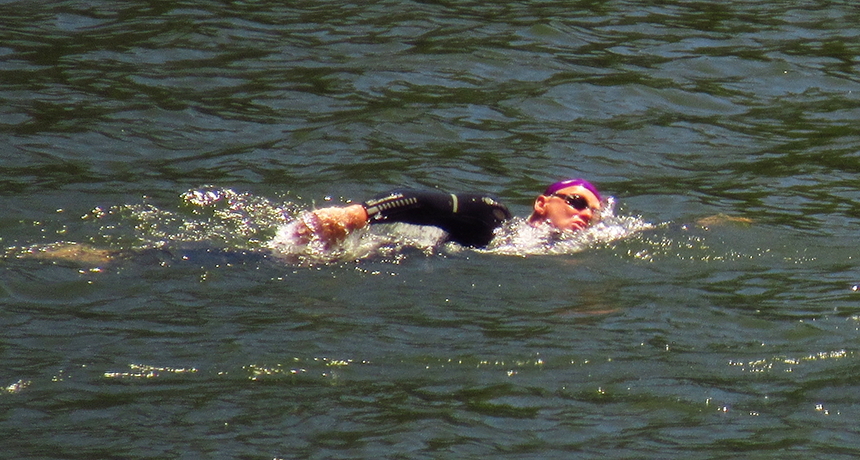
What's hidden in the river? During his epic swim of the Tennessee River, a German scientist sampled — and then studied — the pollutants he encountered.
Courtesy of Andreas Fath
On a clear, sunny Tuesday afternoon, last August, Andreas Fath climbed out of a river in Paducah, Ky. A small crowd was on hand to witness his setting a new world record. This man had just finished swimming the entire length of the Tennessee River — 1,049 kilometers (652 miles). And he did it in just 34 days!
The 52-year-old man had taken on this Herculean swim for science. A chemist from Hochshule Furtwangen University in Germany’s Black Forest, Fath’s month-long swim was part publicity stunt and part ongoing science. His primary goal was not to get his name into Guinness World Records. What really drove this aquatic trek was a desire to bring attention to water pollution.
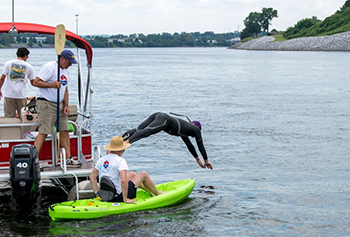
Fath’s crew included his family. They, along with students and other researchers, often took part in the grand adventure. Sometimes they swam with Fath. Other times they cruised nearby on a 6-meter (18-foot) pontoon boat. Every day, that crew collected samples of the water. So did Fath. The wetsuit he wore had a sensor to detect pollutants.
Martin Knoll, who helped organize Fath’s swim, also took part. Knoll is an environmental scientist at the University of the South, in Sewanee, Tenn. He describes this 2017 swim as “a vehicle for getting people interested in water quality” and how we sometimes pollute water without realizing it. He says, “It’s good for people to be aware of all these things.”
Like other scientists, Knoll and Fath are worried about the health of rivers, oceans and other bodies of water. Toxic chemicals, such as pesticides, run off of the land and collect in streams and coastal waters. So do other wastes.
Among them are plastics. One 2016 study suggested that within another 35 years, the oceans could host more plastic (by weight) than fish. Other scientists think that may be an exaggeration. But either way, plastic clearly is a big problem. This and other pollutants affect not just oceans and rivers — like the Tennessee — but all the living things that depend on those bodies of water.
If people knew more about the role that freshwaters play in the health of the overall environment, Fath says, they might think more about the role their activities play in polluting the aquatic world. As a scientist, Fath has published papers on water pollution. That’s a good way to reach other scientists, he says. But to make a bigger splash, he’s turned to staging dramatic adventures. For the public, he notes, “I’ve learned that it’s better to do it this way.”
Story continues below image.
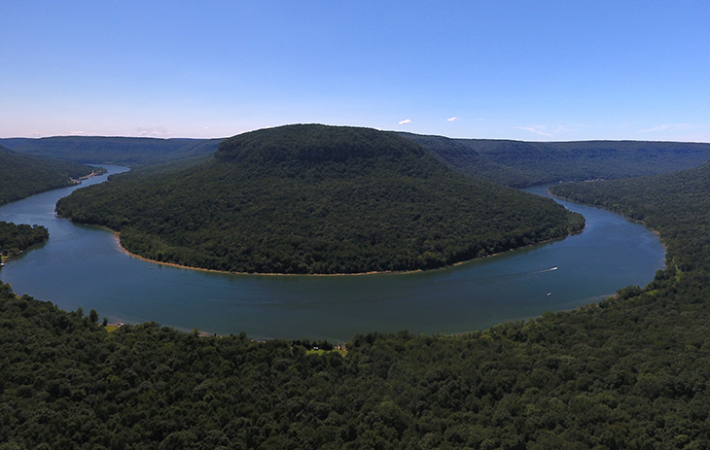
First, the Rhine
The Tennessee wasn’t Fath’s first big swim. Three years earlier, he plunged into Switzerland’s Lake Toma. It marks the starting point of the Rhine River. At 1,231 kilometers (765 miles), the Rhine is somewhat longer than the Tennessee. It’s also international. Its water flows through Switzerland, Germany and the Netherlands. It also hugs parts of the borders of France, Lichtenstein and Austria. Eventually, it empties into the North Sea.
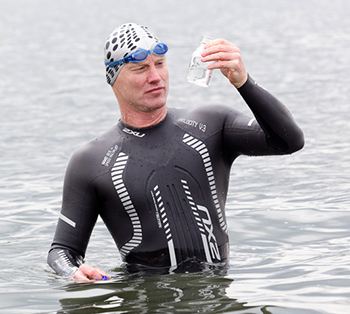
It took Fath 28 days to swim the Rhine’s length. Along the way, his crew took measurements of the water’s temperature and pH. (Measuring pH tells scientists how acidic or alkaline a substance is.) They also recorded weather and the speed of the river’s current. As with the Tennessee, they collected daily water samples. A small plastic device attached to one leg of Fath’s wetsuit sampled the chemical pollutants through which he swam.
That journey, Fath points out, “mixed an adventure story with hard data.”
For instance, Fath and his collaborators screened for more than 600 different chemicals in the collected water samples. To do this they used a variety of tools. Mass spectrometry (Speck-TRAH-meh-tree), for instance, bombards a sample with electrons. (Electrons are negatively charged particles.) The resulting particle soup can reveal what chemicals were in the sample. The scientists also used liquid chromatography (KRO-muh-TAH-gruh-fee). This tool identifies the parts of a mixture by how they interact with other chemicals.
The team described their Rhine data at a meeting of water scientists in November 2014. Their analyses had turned up many different insoluble materials (ones that won’t dissolve in water). How much of each pollutant is present gives clues about the people who live nearby, such as what medications they’re taking.
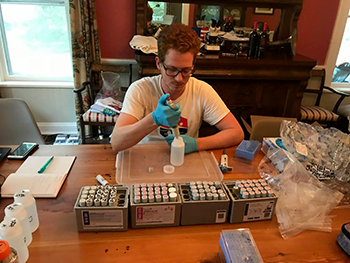
When people take medicine, their bodies often do not use it all. The body excretes the extra in urine or feces. This goes down toilets and then through a town’s sewers. Waste-treatment plants don’t do a good job at scrubbing drugs and many other polluting chemicals from the water. What they don’t remove will end up in rivers.
Polluting medicines can travel long distances. For instance, Fath found traces of a drug to lower blood pressure in Ilanz. It’s a city near the beginning of the Rhine. He also found this same drug all along the rest of river’s length. In Chur, another Swiss town, he found a germ-killing antibiotic known as sulfamethoxazole (SUL-fah-meh-THOX-uh-zoal). Further down, in Lake Constance — which touches Germany, Switzerland and Austria — he found a drug called metoprolol (Meh-TOW-proh-lol). It, too, treats high blood pressure.
Ultimately, Fath’s goal is to use such data to identify the sources of pollution. Then he wants to find ways to keep those chemicals out of the water. The Rhine provides drinking water to 20 million people. Pollutants in the river may also harm animals and plants that live in it.
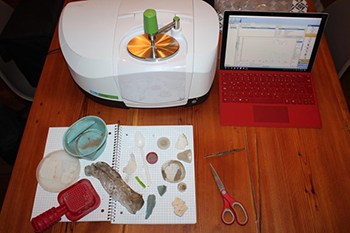
Treatment plants could remove chemicals like these before releasing the water into lakes and streams. But to date, few communities have designed their water-treatment plants to focus on removing such drugs and other lab-made chemicals.
Knoll, at Sewanee, was doing research in Germany when he first met Fath. The two scientists hit it off immediately. When Knoll was a child, his family took vacations in Germany, not far from where Fath lived. “He grew up on one side of the Rhine, and I spent a lot of time on the other as a child,” says Knoll. They discovered they both have three sons. They both swim. They both share a passion for water quality and ecology. In time, says Knoll, “We cooked up this Tennessee swimming idea.” They named their project TenneSwim.
Companions — wild and otherwise
The Tennessee River was a natural choice for Fath’s next big swim, says Knoll. Its length and current are not much different from the Rhine’s. “We knew it was a river he could handle,” says Knoll.
This river also supports more than 200 species of fish. Sturgeon, a fish that can grow up to 3 meters (10 feet) long, have swum here for millions of years. Zipping along the river bottom are small darters, just a few centimeters (an inch or two) long. The river also is home to mussels, salamanders, turtles and other aquatic critters. All of these organisms could be threatened by pollution.
Before Fath started, he had some questions for Knoll — mainly about American wildlife.
Would he encounter snapping turtles? (Maybe.) Poisonous snakes? (Possibly.) What about alligators, which once lived in a lake in Alabama that forms part of the river? (Unlikely.) He’d heard about bull sharks swimming up the Mississippi River, as far north as St. Louis. Knoll reassured Fath that the sharks couldn’t pass through dams on this river.
During the 34-day swim, Fath and his crew spent most nights camping beside the river. His wife and three sons often swam with him for miles at a time. So did several other people who like to swim in big, open waterways like rivers and lakes.
Twice, Fath had to postpone a swim for a few hours to let a storm pass. No snapping turtles harassed him. But Knoll says a few gar — big fish, measuring a meter (39 inches) long — did accompany Fath one day. The team also saw herons and raccoons. Osprey and bald eagles patrolled the skies overhead.
Story continues below image.
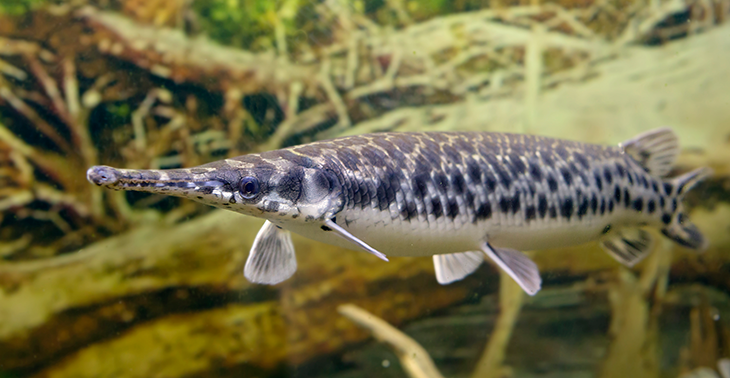
The water was hot and often still. So Fath took breaks, cooling himself with ice. In Kentucky Lake, the final leg of the swim, Fath’s team encountered heavy barge traffic and often had to wait for the big boats to pass.
To power his trek, Fath ate every half-hour. In all, he downed about 12,000 calories per day. That’s four or five times as much as an adult should normally eat — one who’s not midway through a marathon swim, that is. Knoll planned his meals very carefully.
“Psychologically, it helps to have good food,” he says. Otherwise, he says, “You get a mutiny” from your body. One day, recalls Knoll, Fath spied a riverside restaurant. He swam to the dock, climbed out of the river and sat down at a table. Dripping wet he ordered lunch, much to the surprise of other diners.
“The waitress was at a loss,” Knoll says. “We had to tell her what was going on — about the world record” that he was on target to achieve. Fath was aiming to make the fastest swim of the entire river. (A Tennessee teacher named Mimi Hughes held the previous record. She swam the river’s length over five summers.)
Doing science en route
The crew took samples of the river from a boat. Fath had a sensor attached to his ankle that was designed to mimic fish skin. Chemicals and microplastics in the water would attach to it, just as they might to a fish. Later, Fath could analyze the sensor to gauge what had been in the water.
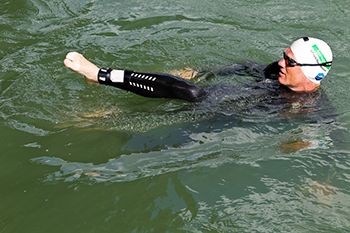
He was particularly interested in microplastics. These bits are less than five millimeters (0.2 inch) across. Insoluble chemicals like pesticides often stick to microplastics. Fish that swim in the water don’t know the difference between these plastic bits and plankton, their ordinary food, so they eat it all. This allows plastics and poisons to accumulate in their bodies. As predators eat those fish, those pollutants can build up in their bodies.
In this way, Knoll explains, “the plastic works its way up the food chain.”
Back in Germany, Fath and his students finished analyzing their data from the Tennessee this past February. They plan to publish their findings soon. One big difference from the Rhine: Fath found higher levels of microplastics in the Tennessee.
Identifying materials that hide in the river isn’t only important for the animals that live there. It’s also a way to protect human health, says Fath. He hopes his work can lead to new filters that can better clean wastewater before communities release it back into any rivers.
These long swims — first in the Rhine, then in the Tennessee — are helping to capture people’s attention. But they’re not cleaning up the water.
“It’s going to take more than 34 days to find solutions to reduce the chemicals in our water,” Fath notes. “I believe that people borrow water from nature,” he says. But it’s not ours to keep, he adds. “We have to give it back to nature.”







